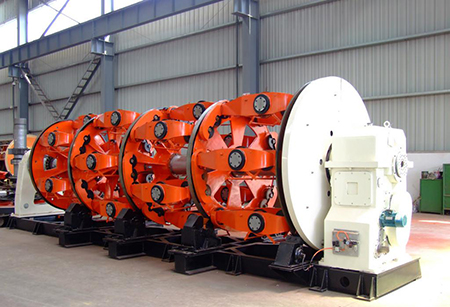In the production of wire and cable, twisting machine occupies a very important position. According to the different stranding forms, as the main equipment for regular stranding (concentric layer stranding), cage type stranding machine, because of its unique advantages, it has gradually become one of the main equipment for producing bare wires and cable conductive cores.

Cage Type Stranding Machine
When the twisted wire is stranded, with the rotation of the cage, the single wire is wound on the cylinder with the base circle as the diameter in a helical manner, and the single wire is bent everywhere, and the single wire also produces torsional deformation around its own axis. The bending and torsional deformation of the single wire makes the stranded wire generate internal stress and affects the quality of the stranded wire. Due to the structure of the stranded wire, the bending deformation of the single wire is unavoidable, and the problem of torsional deformation can be solved by adopting the back-twisting process.
The cage type stranding machine has back-twisting mechanism, which can keep the cradle level during the stranding process, so that the single wire only bends without torsional deformation, and realizes complete back-twisting. Therefore, the quality of the strands stranded by the cage type stranding machine is very good and can meet the requirements of electrical use.
The structure of the cage type stranding machine
The main body of the cage type stranding machine, the pay-off part, is a cage-shaped structural member, commonly known as a twisting cage. 2-6 circular winches are installed on a main shaft, usually 6 cradle-type pay-off frames are a group, and are evenly distributed between the two winches through the twist-back mechanism.
The single wire is released from the pay-off tray of the cradle-type pay-off frame and collected to the closing die through the dividing plate. When stranding, the cage type strander requires two movements. One is that the power drives the main shaft to rotate, so that the twisted single wire can rotate around the main shaft axis. The other is to drag each single wire collected to the closing die and rotate around the main axis forward through the capstan device, thus completing the twisting motion.
Due to the large size of the twisting cage, the twisted wire installed on the cradle-type pay-off frame is also heavy. When the twisting cage rotates at a high speed,, a huge centrifugal inertia force will be generated. Therefore, the support form of the cradle’s pay-off frame is very important, and its quality directly reflects the performance of the twisting cage.
Planetary gear back-twisting mechanism
The back-torque shaft of the planetary gear back-twisting mechanism adopts the form of a spline shaft. The spline shaft is sleeved in the unloading sleeve, and a spline cover is installed at both ends of the spline shaft. The gear can drive the cradle-type pay-off frame to rotate through the spline cover and the spline shaft.
When the cage rotates once, the cradle-type pay-off frame is stationary relative to the fixed central gear, and rotates in the opposite direction relative to the winch. It can be seen that when the cage is rotating, since the central gear is fixed, the cradle-type pay-off frame moves in translation under the action of the planetary gear train to achieve complete back-twisting.
The planetary gear back-twisting mechanism transmits the huge centrifugal inertial force generated when the cradle-type pay-off frame rotates and the required back-twisting motion separately, and the unloading sleeve and the rear support shaft only bear the centrifugal inertial force. Since they are all fixed on the winch through the flange, the support is rigid, the bearing capacity is strong, and the deformation is small.
To sum up, the planetary gear back-twisting mechanism has a reasonable structure, high reliability, low failure rate of the equipment, good production efficiency, and strong comprehensive performance of the equipment.
